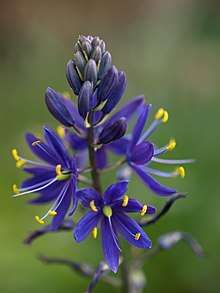Camassia leichtlinii
| Camassia leichtlinii | |
|---|---|
 | |
| Great camas inflorescence | |
| Scientific classification | |
| Kingdom: | Plantae |
| Clade: | Angiosperms |
| Clade: | Monocots |
| Order: | Asparagales |
| Family: | Asparagaceae |
| Subfamily: | Agavoideae |
| Genus: | Camassia |
| Species: | C. leichtlinii |
| Binomial name | |
| Camassia leichtlinii (Baker) S.Watson | |
Camassia leichtlinii, commonly known as great camas or large camas, is a perennial herb. It is one species of the genus Camassia and is native to western North America in British Columbia in Canada and the United States, in California, Nevada, Oregon and Washington.[2]
Description
Great camas is a perennial herb that grows from an edible bulb. camassia leichtlinii can grow from 24-48 inches tall. Leaves are long and narrow, stemming from the basal rosette. The inflorescence is a spike-like cluster on a leafless stem that is held above the leaves.[3] It is similar enough to be easily mistaken for the more common camassia quamash.
Ecology
The range of Camassia leichtlinii often overlaps with the more common Camassia quamash. "Great camas grows in wet meadows, woods, prairies, moist hillsides, and streamside areas. Camas habitat is often ephemeral, and dries up by late spring. Great camas grows from south Vancouver Island to northern California, from the coast to the Cascade and Sierra Nevada Mountains at elevations below 10,800 feet."[3] Camassia leichtlinii needs consistent moisture in the spring, but will not be harmed by seasonal drought after the seed pods mature and the leaves dry out. Camassia stands can benefit from seasonal fires as well, it aids in regeneration and reduces competition from brush and weeds.[3]
References
- ↑ "Camassia leichtlinii". NatureServe Explorer. NatureServe. Retrieved 2018-04-07.
- ↑ "Comprehensive Report Species -". explorer.natureserve.org. Retrieved 2018-04-11.
- 1 2 3 "Great Camas" (PDF). December 5, 2000. Retrieved April 10, 2018.
